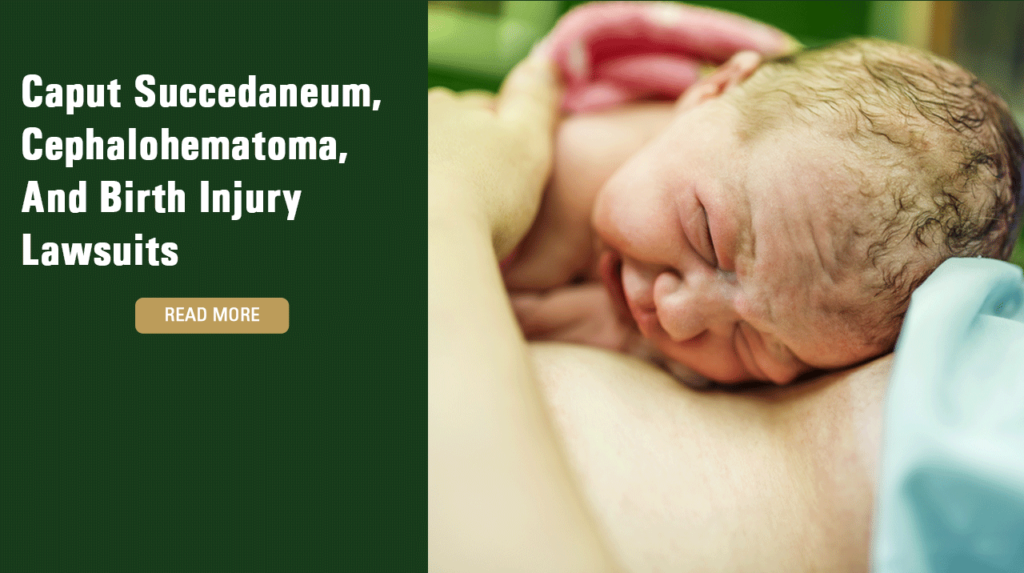Caput Succedaneum, Cephalohematoma, And Birth Injury Lawsuits

Expecting parents often worry about their infants and hope that everything goes well during and after birth. While the rate of birth injuries is low, they still sometimes occur. Tens of thousands of infants suffer from preventable birth injuries every year. In some cases, these injuries result because of the negligence of doctors and other health care professionals. If you have learned that your child’s birth injury might have happened because of the mistakes made by your health care providers, you should speak to a birth trauma attorney at Raynes & Lawn about your potential claim.
What Causes Birth Injuries To The Head?
Many birth injuries are caused by trauma to the baby’s head. The infant’s head is vulnerable and can easily be injured during childbirth. In some cases, doctors use too much force during delivery and cause traumatic head injuries.
In some cases, the damage caused by excessive force can rupture blood vessels and cause bleeding to occur between the baby’s scalp and skull. The pressure can be caused by repeated compressions of the infant’s head against the pelvic wall during labor. It can also occur when a doctor applies too much force on the baby’s head while improperly using delivery-assistive devices, including vacuum extractors and forceps. Depending on the amount of bleeding, the blood can pool and place pressure on the periosteum and cause a distinctive lump to appear on your baby’s forehead.
What Is Caput Succedaneum?
Caput succedaneum occurs when the infant’s scalp swells during labor and following delivery. It occurs because of prolonged pressure placed on the baby’s head by the walls of the vagina or the cervix during delivery. It can also be caused by forceps or vacuum extractors.
What Is Cephalohematoma?
Cephalohematoma occurs when blood pools between the baby’s skull and scalp because of blood vessel ruptures during labor and delivery. It can happen during birth or shortly following it. In most cases, it is not serious. Between 1% and 2% of all infants will have cephalohematoma. Most cases heal on their own within a few months. A cephalohematoma might appear as an irregular, soft bump on the back of your baby’s head.
What Is The Difference Between Caput Succedaneum And Cephalohematoma?
Both cephalohematoma and caput succedaneum have symptoms of swelling on the baby’s head or unusual bumps. However, succedaneum is caused by scalp swelling caused by pressure while cephalohematoma is caused by bleeding between the scalp and the skull.

In most cases, neither caput succedaneum nor cephalohematoma is serious. However, these conditions can cause other complications, including infections or jaundice, if they are not properly treated. For example, trying to drain excess fluid from an infant’s scalp can result in an infection. This is why doctors generally recommend allowing these conditions to resolve on their own.
Symptoms Of Cephalohematoma And Caput Succedaneum
A baby who has caput succedaneum or cephalohematoma will typically show a soft swollen area on the top of the head. the swollen area might appear puffy and will appear on the spot on the baby’s head that left the birth canal. You might see some mild bruising or discoloration. In more severe cases involving cephalohematoma, you might see more severe bruising or discoloration.
Some of the common signs of cephalohematoma or caput succedaneum include the following:
- Soft, bulging spot on the head
- Swelling
- Slightly pointed head
- Anemia
- Bruising and discoloration
- Puffy area below the scalp
- High-pitched, constant crying
- Trouble feeding
- Varying head circumference, diameter, and structure
Infants might show symptoms right after birth and up to a few months following it. However, these conditions typically go away on their own.
Medical Malpractice And Birth Injuries
Doctors and other medical professionals must provide treatment that meets the standard of care expected of reasonably competent physicians in their respective practice areas. If a doctor makes medical mistakes that cause birth injuries, he or she might be liable and be forced to pay damages for your losses.
Medical professionals are supposed to try to minimize the chances of injury when they are assisting in the labor and delivery process. If your doctor incorrectly treated your infant’s caput succedaneum or cephalohematoma and caused your baby to develop a serious infection, jaundice, or other problems, they might be liable for medical malpractice. Similarly, if your doctor improperly used forceps and caused your baby to suffer a brain injury and permanent damage, you might have a viable malpractice lawsuit.
Speak To A Child Injury Lawyer At Raynes & Lawn
If your baby sustained a birth injury, you might feel heartbroken and overwhelmed. Certain types of birth injuries can have long-lasting impacts on your child’s life. If you believe that your child’s injury was caused by the negligence of the attending doctor or another medical professional, you should talk to the attorneys at Raynes & Lawn.
Our medical malpractice team has fought for the rights of negligence victims for more than 50 years and has recovered billions of dollars for our clients. We can help you understand whether what happened to you and your baby provides valid grounds for a malpractice claim. If we agree to accept your case, we will work hard to recover maximal compensation for your losses. Call us today at 1-800-535-1797 to request a free case evaluation.

For the general public: This Blog/Website is made available by the law firm publisher, Raynes & Lawn, for educational purposes. It provides general information and a general understanding of the law but does not provide specific legal advice. By using this site, commenting on posts, or sending inquiries through the site or contact email, you confirm that there is no attorney-client relationship between you and the Blog/Website publisher. The Blog/Website should not be used as a substitute for competent legal advice from a licensed attorney in your jurisdiction.
For attorneys: This Blog/Website is informational in nature and is not a substitute for legal research or a consultation on specific matters pertaining to your clients. Due to the dynamic nature of legal doctrines, what might be accurate one day may be inaccurate the next. As such, the contents of this blog must not be relied upon as a basis for arguments to a court or for your advice to clients without, again, further research or a consultation with our professionals.
